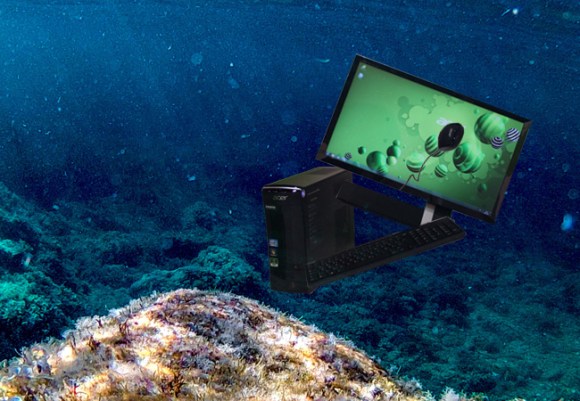
Under the sea. Under the Seaaaaa!♪ You can overclock your processor, under the seaaaaa!♫
■ Hot and bothered
Heat has always been a foe of computers. Especially when pushing them to the limit, users always run the risk of burning out key parts. At those times when you want to get Crysis 3 running nicely, you just wish you could toss that sucker into the sea to cool it down.
Well, that may soon become a realistic option thanks to the efforts of Professors Michihiro Koibuchi and Kazuki Fujiwara of the National Institute of Informatics who have been developing a Suibotsu Computer (Submersible Computer) capable of operating under water.
Common sense tells us that putting a computer into water will result in problems. Of course, the high conductivity of water would easily short it out and then proceed to corrode its sensitive circuitry just to rub it in. But with products like the new iPhone being waterproof, how hard would it be to make a waterproof computer?
■ Trial and error
Quite hard, according to Koibuchi and Fujiwara, who had to trudge through several trial and error approaches. First they discovered a type of epoxy resin that could insulate the electric currents preventing shorts and waterproof to repel the damaging effects of the water. However, it failed because even with the most careful painting it was impossible to completely cover the computer for full protection.
They then tried putting the computer in an aluminum box and sealed the joints with a waterproof substance. But even that couldn’t keep the circuitry completely dry when submerged.
Eventually the pair came across a substance called paraxylene which has similar benefits to the epoxy they previously tried. However, paraxylene had the added ability to be applied in gaseous form. When applying the resin as a gas, the molecular bonds are loose as it coats the surface. Then, when it cools the bonds shrink and tighten creating a firm yet thin waterproof film of about 0.1 millimeters.
■ Take computing for a long walk off a short pier
So Koibuchi and Fujiwara coated a motherboard using this technique and put it in a fish tank full of tap water for three months. During this time, the CPU continuously ran without a problem and at a comfortable temperature.
Next, the professors coated two motherboards to test how seaworthy they would be. In late July they tossed the two boards off a dock in Yokosuka connected to a power source on land by a waterproof cable. It was an unexpectedly rough summer, with early typhoons causing choppy conditions in the sea.
▼ The men used ASRock Mini-ITX motherboards for their tests – a surprisingly expensive choice for something they’re just going to chuck into the ocean
Nevertheless, one of the motherboards had exceeded the researcher’s initial goal of running continuously for one week, and stayed on for an entire month. However, the other motherboard didn’t make it.
After retrieving them from the water, they found that crustaceans and seaweed had begun living on them. A crab had squatted in the case of one motherboard. Seeing this, they deduced that it was likely some shellfish had eaten through the protective layer of the broken board causing it to fail.
Considering the sea run a success, Koibuchi and Fujiwara are now working on waterproofing an entire computer to try out under water. This is much more difficult and requires strategic coating of the resin to balance cooling effects and waterproofing in the areas that need each the most.
■ Environmental boon or bomb?
This is a lot of effort and cost to go through to waterproof a single computer, but the aim of this project is to reduce the cost and energy consumption of large scale data centers. For example, Google’s data centers are said to use about 260 million watts of power (equivalent to 200,000 homes) with much of that power being used for cooling.
Placing these large scale servers in a natural body of water can significantly reduce the environmental impact and cost of the intense 24-hour air conditioning required. Koibuchi and Fujiwara also hope that these underwater servers can be powered by the tides and waves reducing power consumption even more.
Before such a future is achieved, more research will be needed to ensure that the act of putting computer systems into rivers and oceans doesn’t come with other adverse affects to the environment.
But at the very least, we may soon see a future where we no longer have to worry about dropping our desktop PCs in the toilet.
…I have a very small apartment.
Source: NHK, My Game News Flash (Japanese), Storage Servers (English)
Top Image: Wikipedia/Yassin Grayaa, Wikipedia/Michael Movchin (Edited by RocketNews24)
Inset Images: Amazon


 Disillusionment at Tsukiji’s tourist-target prices led us to a great ramen restaurant in Tokyo
Disillusionment at Tsukiji’s tourist-target prices led us to a great ramen restaurant in Tokyo Japan may add Japanese language proficiency, lifestyle classes to permanent foreign resident requirements
Japan may add Japanese language proficiency, lifestyle classes to permanent foreign resident requirements 7-Eleven Japan starts new temporary luggage storage service in over 300 branches
7-Eleven Japan starts new temporary luggage storage service in over 300 branches Lacquerware supplier to emperor of Japan and Pokémon team up for new tableware
Lacquerware supplier to emperor of Japan and Pokémon team up for new tableware Tokyo’s Tsukiji sushi neighborhood asks tour groups to stay away for the rest of the month
Tokyo’s Tsukiji sushi neighborhood asks tour groups to stay away for the rest of the month Disillusionment at Tsukiji’s tourist-target prices led us to a great ramen restaurant in Tokyo
Disillusionment at Tsukiji’s tourist-target prices led us to a great ramen restaurant in Tokyo Japan may add Japanese language proficiency, lifestyle classes to permanent foreign resident requirements
Japan may add Japanese language proficiency, lifestyle classes to permanent foreign resident requirements 7-Eleven Japan starts new temporary luggage storage service in over 300 branches
7-Eleven Japan starts new temporary luggage storage service in over 300 branches Lacquerware supplier to emperor of Japan and Pokémon team up for new tableware
Lacquerware supplier to emperor of Japan and Pokémon team up for new tableware Tokyo’s Tsukiji sushi neighborhood asks tour groups to stay away for the rest of the month
Tokyo’s Tsukiji sushi neighborhood asks tour groups to stay away for the rest of the month Unique Starbucks in historic building is one of the most beautiful in Japan
Unique Starbucks in historic building is one of the most beautiful in Japan Dove ad slams Japanese beauty ideals, backfires with complaints from public instead
Dove ad slams Japanese beauty ideals, backfires with complaints from public instead The 10 best Japanese hot spring resorts locals want to go back to again and again
The 10 best Japanese hot spring resorts locals want to go back to again and again The 10 best ryokan inns in Japan, as chosen by travelers
The 10 best ryokan inns in Japan, as chosen by travelers Six non-traditional osechi New Year’s meals in Japan
Six non-traditional osechi New Year’s meals in Japan Starbucks teams up with 166-year-old Kyoto doll maker for Year of the Horse decorations【Photos】
Starbucks teams up with 166-year-old Kyoto doll maker for Year of the Horse decorations【Photos】 Street Fighter Hadouken Churros to be launched and eaten in Tokyo, Okami pudding on offer too
Street Fighter Hadouken Churros to be launched and eaten in Tokyo, Okami pudding on offer too Japanese woman mistaken for bear
Japanese woman mistaken for bear Return of Totoro sequel short anime announced for Ghibli Park
Return of Totoro sequel short anime announced for Ghibli Park Starbucks Japan releases new zodiac chilled cup drink for 2026
Starbucks Japan releases new zodiac chilled cup drink for 2026 Is this the most relaxing Starbucks in Japan?
Is this the most relaxing Starbucks in Japan? Starbucks on a Shinkansen bullet train platform: 6 tips for using the automated store in Japan
Starbucks on a Shinkansen bullet train platform: 6 tips for using the automated store in Japan Japan’s human washing machines will go on sale to general public, demos to be held in Tokyo
Japan’s human washing machines will go on sale to general public, demos to be held in Tokyo Japanese train company is letting fans buy its actual ticket gates for their homes
Japanese train company is letting fans buy its actual ticket gates for their homes Is China’s don’t-go-to-Japan warning affecting tourist crowds in Tokyo’s Asakusa neighborhood?
Is China’s don’t-go-to-Japan warning affecting tourist crowds in Tokyo’s Asakusa neighborhood? Starbucks Japan unveils new Christmas goods and a rhinestone tumbler that costs 19,500 yen
Starbucks Japan unveils new Christmas goods and a rhinestone tumbler that costs 19,500 yen Tokyo considering law requiring more trash cans following litter increase in heavily touristed area
Tokyo considering law requiring more trash cans following litter increase in heavily touristed area Nintendo’s Kirby now delivering orders at Kura Sushi restaurants, but not in Japan
Nintendo’s Kirby now delivering orders at Kura Sushi restaurants, but not in Japan Tokyo event lets you travel back in time, for free, to celebrate 100 years since Showa era start
Tokyo event lets you travel back in time, for free, to celebrate 100 years since Showa era start Survey asks foreign tourists what bothered them in Japan, more than half gave same answer
Survey asks foreign tourists what bothered them in Japan, more than half gave same answer Japan’s deadliest food claims more victims, but why do people keep eating it for New Year’s?
Japan’s deadliest food claims more victims, but why do people keep eating it for New Year’s? We deeply regret going into this tunnel on our walk in the mountains of Japan
We deeply regret going into this tunnel on our walk in the mountains of Japan Studio Ghibli releases Kodama forest spirits from Princess Mononoke to light up your home
Studio Ghibli releases Kodama forest spirits from Princess Mononoke to light up your home Major Japanese hotel chain says reservations via overseas booking sites may not be valid
Major Japanese hotel chain says reservations via overseas booking sites may not be valid Put sesame oil in your coffee? Japanese maker says it’s the best way to start your day【Taste test】
Put sesame oil in your coffee? Japanese maker says it’s the best way to start your day【Taste test】 The top 10 annoying foreign tourist behaviors on trains, as chosen by Japanese people【Survey】
The top 10 annoying foreign tourist behaviors on trains, as chosen by Japanese people【Survey】 No more using real katana for tourism activities, Japan’s National Police Agency says
No more using real katana for tourism activities, Japan’s National Police Agency says Starbucks Japan reveals new sakura drinkware collection, inspired by evening cherry blossoms
Starbucks Japan reveals new sakura drinkware collection, inspired by evening cherry blossoms Unique Starbucks in historic building is one of the most beautiful in Japan
Unique Starbucks in historic building is one of the most beautiful in Japan Dove ad slams Japanese beauty ideals, backfires with complaints from public instead
Dove ad slams Japanese beauty ideals, backfires with complaints from public instead The 10 best Japanese hot spring resorts locals want to go back to again and again
The 10 best Japanese hot spring resorts locals want to go back to again and again The 10 best ryokan inns in Japan, as chosen by travelers
The 10 best ryokan inns in Japan, as chosen by travelers Six non-traditional osechi New Year’s meals in Japan
Six non-traditional osechi New Year’s meals in Japan Let’s make sashimi with…whatever in God’s name this thing is【SoraKitchen】
Let’s make sashimi with…whatever in God’s name this thing is【SoraKitchen】 Japan creates public monument to original doge meme dog in her home prefecture【Photos】
Japan creates public monument to original doge meme dog in her home prefecture【Photos】 Studio Ghibli releases anime art calendars for 2025
Studio Ghibli releases anime art calendars for 2025 One couple, two beds – Why do so many Japanese spouses sleep separately?
One couple, two beds – Why do so many Japanese spouses sleep separately? 11 different ways to say “father” in Japanese
11 different ways to say “father” in Japanese Starbucks Japan releases new zodiac chilled cup drink for 2026
Starbucks Japan releases new zodiac chilled cup drink for 2026 “Where are the normal men?” A Japanese woman tells of five online dating woes
“Where are the normal men?” A Japanese woman tells of five online dating woes Sukiyabashi Jiro Sushi Rice: How good is rice from Japan’s legendary sushi restaurant?
Sukiyabashi Jiro Sushi Rice: How good is rice from Japan’s legendary sushi restaurant?
Leave a Reply